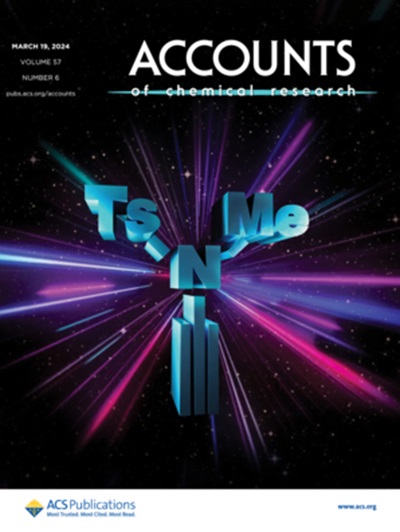炔苯环:高效合成手性和非手性纳米石墨烯及石墨烯纳米带的有力工具。
IF 16.4
1区 化学
Q1 CHEMISTRY, MULTIDISCIPLINARY
引用次数: 0
摘要
摘要多环芳烃(PAHs)由于其扩展的π-电子系统而具有潜在的光学和电子特性,在有机电子设计中变得无处不在。这些特性──主要是吸收性、发射性和半导体性──可以通过改变分子骨架的大小和形状、在核心结构中加入杂原子以及沿外围功能化来调整,以适应特定的器件应用。为此,多环芳烃的合成设计需要多种多样的方法来快速扩展π-电子系统,而不牺牲材料加工成器件的溶解度。炔苄基环化是合成此类多环芳烃的有力工具,因为从高能三键生成芳香环的能量下降过程。此外,炔烃的功能化不仅可以增加溶解度,还可以增加主链中的空间应变,从而产生高度扭曲的,甚至手性的结构。由于苯并环制过程在能量上是如此有利,即使是这些非常紧张的多环芳烃也可以在温和的条件下相对容易地合成。在这篇文章中,我们总结了我们的工作和我们的方法的发展,利用炔苄环合成扭曲的,在许多情况下,手性,多环芳烃,以及高可溶性石墨烯纳米带。三氟乙酸(TFA)是有效的苯并化炔到数据凝聚多环芳烃体系,产生类菲的部分。然而,我们发现,要生成具有类芘基团的半缩合体系,需要一种更强的Brønsted酸,如三羧酸(TfOH)。我们将TFA在温和条件下对一半的炔进行干净的苯并环化,然后用TfOH对剩余的炔进行苯并环化,这一组合在5-armchair石墨烯纳米带及其低聚物芘的合成中发挥了很大的作用。不幸的是,这种方法仅限于含有富电子芳香取代基的炔。为了克服这一障碍并扩大反应范围,我们对Lewis酸催化剂进行了筛选,发现在较温和的反应条件下,与Brønsted酸相比,InCl3对含较少富电子芳烃的炔,甚至只含烷基链的炔都有效。用这两种方法合成了第一手性苝和第一手性teropyrene,以及其他具有扭转烯和螺旋烯手性的化合物。我们后来发现,添加AgNTf2助催化剂可以提高InCl3的刘易斯酸度,从而在保持反应条件温和的情况下实现更困难的苄环反应。这些炔苄环化的方法使我们能够控制多环芳烃骨架的大小和形状,从而使我们能够控制光学和电子性质,从而给我们一套在可见光谱中表现出吸收和荧光的化合物。本文章由计算机程序翻译,如有差异,请以英文原文为准。
Alkyne Benzannulations: A Powerful Tool for the Efficient Synthesis of Chiral and Achiral Nanographenes and of Graphene Nanoribbons.
ConspectusPolycyclic aromatic hydrocarbons (PAHs) have become ubiquitous in the design of organic electronics due to their extended π-electron systems that give rise to potentially useful optical and electronic properties. These properties─chiefly absorption, emission, and semiconductivity─can be tuned to suit a particular device application through changes to the size and shape of the molecule's backbone, through incorporation of heteroatoms into the core structure, and through functionalization along the periphery. To that end, synthetic design of PAHs necessitates versatile methodology to rapidly expand the π-electron system without sacrificing the solubility that allows the materials to be processed into devices.Alkyne benzannulation is a powerful tool for the synthesis of such PAHs due to the energetically downhill process of making an aromatic ring from a high-energy triple bond. Furthermore, functionalization of the alkynes can increase not only solubility but also steric strain in the backbone, resulting in highly contorted, even chiral, structures. Because the benzannulation process is so energetically favorable, even these very strained PAHs can be synthesized with relative ease under mild conditions.In this Account, we summarize our work and the development of our methods for utilizing alkyne benzannulation to synthesize contorted, and in many cases chiral, PAHs, as well as highly soluble graphene nanoribbons. Trifluoroacetic acid (TFA) is effective for the benzannulation of alkynes to cata-condensed PAH systems, creating phenanthrene-like moieties. However, we found that to generate peri-condensed systems with pyrene-like moieties, a much stronger Brønsted acid, such as triflic acid (TfOH), is required. Our combination of TFA for clean benzannulation of half of the alkynes under mild conditions, followed by TfOH to complete benzannulation of the remaining alkynes, was used to great effect in the synthesis of 5-armchair graphene nanoribbons and their oligomers, the pyrenacenes. This method was, unfortunately, limited to alkynes bearing electron-rich aromatic substituents. To overcome this obstacle and broaden the scope, we screened Lewis acid catalysts and found that InCl3 is effective for alkynes bearing much less electron-rich aromatics, and even alkynes bearing only alkyl chains, under milder reaction conditions than with the Brønsted acids. With these two methods, we synthesized the first chiral peropyrenes and the first chiral teropyrene, as well as other compounds exhibiting twistacene and helicene chirality. We later found that the Lewis acidity of InCl3 can be increased by the addition of a AgNTf2 cocatalyst to effect more difficult benzannulations while keeping the reaction conditions mild. These methods of alkyne benzannulation allow us a great deal of control over the size and shape of the PAH backbone, thereby giving us control over the optical and electronic properties, to give us a suite of compounds that exhibit absorption and fluorescence across the visible spectrum.
求助全文
通过发布文献求助,成功后即可免费获取论文全文。
去求助
来源期刊

Accounts of Chemical Research
化学-化学综合
CiteScore
31.40
自引率
1.10%
发文量
312
审稿时长
2 months
期刊介绍:
Accounts of Chemical Research presents short, concise and critical articles offering easy-to-read overviews of basic research and applications in all areas of chemistry and biochemistry. These short reviews focus on research from the author’s own laboratory and are designed to teach the reader about a research project. In addition, Accounts of Chemical Research publishes commentaries that give an informed opinion on a current research problem. Special Issues online are devoted to a single topic of unusual activity and significance.
Accounts of Chemical Research replaces the traditional article abstract with an article "Conspectus." These entries synopsize the research affording the reader a closer look at the content and significance of an article. Through this provision of a more detailed description of the article contents, the Conspectus enhances the article's discoverability by search engines and the exposure for the research.
 求助内容:
求助内容: 应助结果提醒方式:
应助结果提醒方式:


